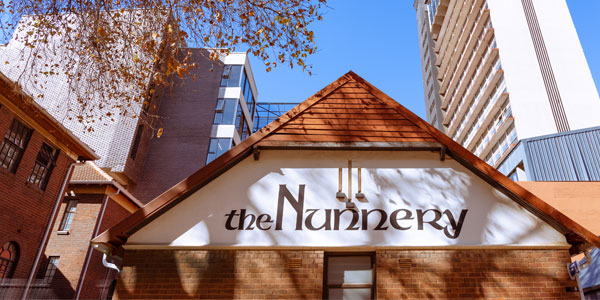
Weekend theatrics so the show could go on
- Deborah Minors
The solution was to convert the school hall of the McAuley House convent, The Nunnery, into a theatre – over one weekend.

Although public productions were previously mounted in the Great Hall, Wits drama and music students lacked a bespoke ‘laboratory’ in which to practise their craft. John van Zyl and Aart de Villiers (1931-1999), Wits staff who became founding members of the University’s drama department, approached Herbert Prins in the Wits School of Architecture to help design a new theatre space.
In 1975, Prins sought out Malcolm Purkey, an English honours student at Wits, and together they designed and built the theatre, for which Vice-Chancellor Guerino Renzo Bozzoli (1968–1977) had reluctantly made around R3 000 available.
“Herbert Prins was charged with the responsibility of creating a theatre for the newly emerging School of Dramatic Art and [the University] wasn’t ready to build The Wits Theatre proper for some years,” says Purkey. “So Herbert scouted about and located the possible place to build it, and he knew that I’d been involved in building the Box Theatre before that, and so he found me, and together we designed the space very unusually and creatively. And then we set to work to build it.”
The solution to converting a hall into a theatre was to fashion narrow galleries on two sides with seats at the entrance. This would create a foyer. Removable seats on the hall’s existing stage created a ‘theatre-in-the-round’ formation – where the audience surrounds the stage. The proximity brings the actors and audience into the same space, fostering a more intimate audience experience.
“Malcolm and I met on a Saturday morning and stood in Ameshoff Street and, as men came by, we accosted them and asked whether they were looking for work. We put together a gang of workers, all unqualified, and started erecting what I believe is still in place, at The Nunnery,” Prins recalled in an article he wrote for the Heritage Portal in November 2015. “Thanks to Malcolm and the off-the-street labour that were paid by the day, and those who were generous enough to donate materials, we built The Nunnery on Saturday and Sunday.”
Prins (1928-2020) became Head of the Department of Architecture at Wits and a celebrated architect who received the University’s Gold Medal in 2019.
Purkey recalls ‘the golden days’ of theatre: “After we built The Nunnery, it became a preferred space for anyone who wanted to make unusual theatre – Barney Simon used it for certain productions in the most innovative way, the Junction Avenue Theatre Company, under my direction, had the world premiere of The Fantastical History of a Useless Man there – a very successful production that used the extraordinary structure of The Nunnery to its fullest advantage.”
Purkey became Head of the School of Dramatic Art at Wits, where he lectured from 1983 to 2004. He then joined the Market Theatre and its Foundation as creative director. He is presently also the Dean of AFDA Joburg, the School for the Creative Economy.
The Nunnery has endured for some 50 years, incubating student theatre performance, music and dramatic arts as well as public productions. In 1983, the Wits Theatre Complex, opposite The Nunnery, was established. Today, as Wits approaches its centenary in 2022, The Nunnery is contained within the precinct housing the refurbished Department of Digital Arts and the new Chris Seabrooke Music Hall.
- Deborah Minors is Senior Communications Officer for Wits University.
- This article first appeared in Curiosity, a research magazine produced by Wits Communications and the Research Office.
- Read more in the 12th issue, themed: #Solutions. We explore #WitsForGood solutions to the structural, political and socioeconomic challenges that persist in South Africa, and we are encouraged by astounding ‘moonshot moments’ where Witsies are advancing science, health, engineering, technology and innovation.

